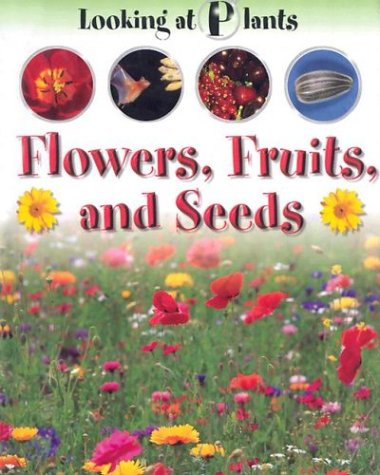-
Seeds and Fruits
Melanie Waldron
Paperback (Raintree, Jan. 1, 2014)Seeds and fruits carry out vital jobs for all flowering plants. New plants are created from seeds and fruits help to protect and spread those seeds. This book provides readers with a complete and comprehensive understanding of the role of seeds and fruit, their structure and how they are brilliantly designed to do these jobs. Clear diagrams, engaging text, and stunning photographs are used to explain the huge variation in seeds and fruits, what seeds and fruit are for, the parts of a flowering plant, how seeds are made, what's inside a seed, what seeds need to germinate, different types of fruit, methods plants use to disperse seeds, and our relationship with seeds and fruits. A wide range of examples present readers with seeds and fruit they will be familiar with plus spectacular and unusual examples from around the world. These demonstrate what different seeds and fruit have in common and some incredible seed and fruit adaptations that allow plants to survive in different conditions and habitats. Two simple activities help stimulate thought, reinforce learning, and bring the concepts to life. Q
Q
-
Seeds and Fruits
Melanie Waldron
Library Binding (Raintree, Jan. 1, 2014)Seeds and fruits carry out vital jobs for all flowering plants. New plants are created from seeds and fruits help to protect and spread those seeds. This book provides readers with a complete and comprehensive understanding of the role of seeds and fruit, their structure and how they are brilliantly designed to do these jobs. Clear diagrams, engaging text, and stunning photographs are used to explain the huge variation in seeds and fruits, what seeds and fruit are for, the parts of a flowering plant, how seeds are made, what's inside a seed, what seeds need to germinate, different types of fruit, methods plants use to disperse seeds, and our relationship with seeds and fruits. A wide range of examples present readers with seeds and fruit they will be familiar with plus spectacular and unusual examples from around the world. These demonstrate what different seeds and fruit have in common and some incredible seed and fruit adaptations that allow plants to survive in different conditions and habitats. Two simple activities help stimulate thought, reinforce learning, and bring the concepts to life. Q
Q
-
Fruits & Seeds
David Schwartz, Dwight Kuhn
Paperback (Creative Teaching Pr, Oct. 1, 1998)Just try to keep these books on the shelves! Children can't resist "diving" into these brightly colored books to explore their favorite topics. Young scientists will examine plant parts and animal features "up close" and then turn the page to see how these smaller parts fit into the "bigger picture." Children will take a close-up view of the powerful ears of a bat, the thorny stem of a blackberry bush, the sticky tongue of a fly, and more. Also perfect for five-senses study, this 24-book series of books features outstanding photographs by renowned nature photographer Dwight Kuhn and easy-to-read text by award-winning children's author David M. Schwartz. M
M
-
Seeds and Fruits
Melanie Waldron, HL Studios
Paperback (Raintree, )None Q
Q
-
Seeds and Fruits
Melanie Waldron
Hardcover (Raintree, June 5, 2014)The books in this series uncover the amazing and clever ways in which every part of a plant is designed to do a specific job. Photographs show plants readers will be familiar with plus spectacular and unusual examples from around the world. Q
Q
-
Flowers, Fruits and Seeds
Angela Royston
Library Binding (Rigby Interactive Library, Jan. 1, 1999)An introduction to how plants reproduce, discussing buds, flowers, fruits, nuts, pods, pollination, and the dispersal of seeds. N
N
-
Flowers, Fruits and Seeds
Angela Royston
Paperback (Heinemann, July 19, 2001)Why do plants have flowers? How do some animals help make new plants? What is pollen? Welcome to the world of Flowers, Fruits and Seeds, where you'll learn the answers to these questions and more! N
N
-
Flowers, Fruits and Seeds
Sally Morgan
Hardcover (Chrysalis Books, Aug. 28, 2002)None
-
Flower, Fruits and Seeds
Sally Morgan
Library Binding (Thameside Pr, Jan. 1, 2003)None Q
Q
-
Flowers, Fruits and Seeds
Angela Royston
Paperback (Heinemann Educational Books Ltd, March 16, 2000)A discussion of flowers, fruits and seeds, suitable for children between the ages of five and seven. The study of plants is an important part of early science teaching and this book is part of a series which approaches it in a way that seeks to be both age and curriculum appropriate. Four of the titles explain the theory of plant life (life cycle, pollination, germination and more) and the other two titles illustrate this information using plants that can be seen in different locations around the UK. The books use simple text and photography, and each spread builds on information presented in the previous ones. There are also simple activities to reinforce learning, such as "Grow Your Own" and "Can You Spot..?" J
J
-
Flowers, Fruits and Seeds
Sally Morgan
Paperback (Chrysalis Books Group, July 31, 2004)None
-
Flowers, Fruits and Seeds
University of Chicago Bertha Morris Parker, Laboratory Schools, University of Chicago Orlin D Frank, Laboratory Schools
Pamphlet (Row-Peterson and Co, March 15, 1941)Intermediate